Flake Epoxy Flooring
If you’re looking for a garage floor coating that’s tough, slip-resistant, easy to clean, and actually looks sharp—flake epoxy is the system I recommend.
Springfield | Decatur | Champaign | Urbana | Mattoon | Shelbyville | Clinton | Lincoln | Arcola | St. Joseph | Charleston | Sullivan | Monticello | Arthur | Tolono | Rochester | Forsyth | Mahomet | Tuscola | Taylorville
What Is a Flake Epoxy System?
Whether it’s your home garage, workshop, or even a retail space, I’ll help you get a floor that can handle life’s wear and tear while upgrading the whole look of your space. And yes, every floor comes with a 15-year warranty —because I know how well it holds up.
A flake epoxy system is more than just a paint job—it’s a full flooring upgrade. It’s built in layers, and each one plays a role in making your floor tougher, safer, and better looking.
Here's How It Works:
Base Coat
We start with a pigmented epoxy base that bonds directly to the concrete. It locks everything down and sets the tone for the flake layer.

Flake Broadcast
While the base is still wet, we broadcast vinyl color flakes across the surface. You can go full broadcast for a dense, seamless look or dial it back for a more subtle texture. These flakes come in a variety of colors and blends—classic grays, modern earth tones, or something bold if that’s your style.
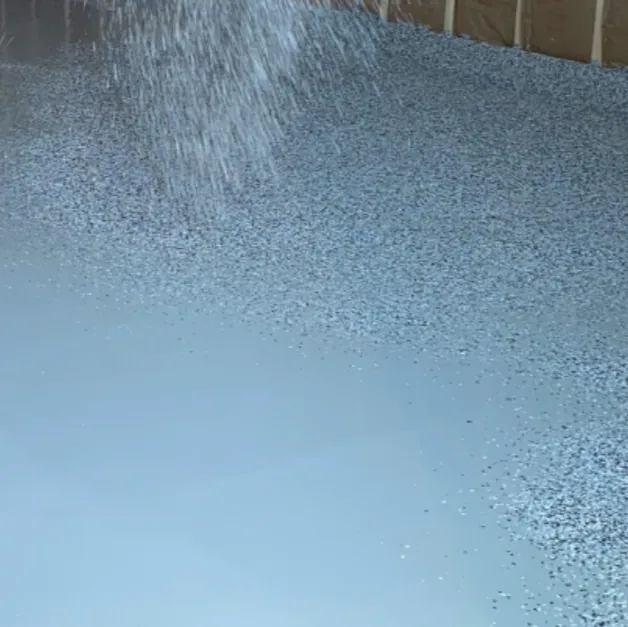
Topcoat
Once the flakes are locked in and the surface is scraped smooth, we finish with a high-performance clear coat. This seals everything in, adds UV protection, and gives you a clean, slightly textured finish that’s both durable and easy to clean.
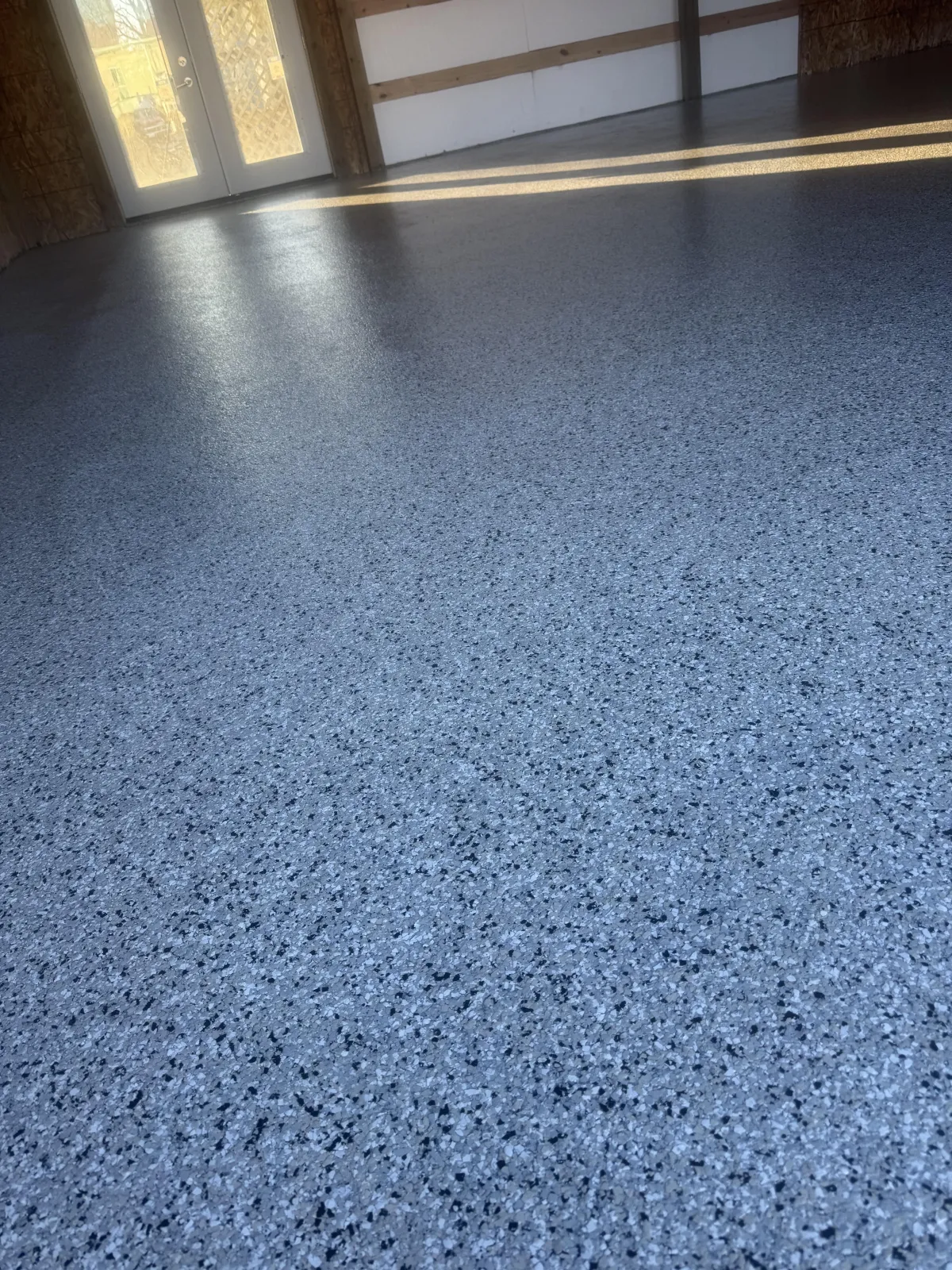
Prep Is Everything—Here’s Why It Matters
A flake epoxy floor is only as good as the prep underneath it. You could buy the most expensive materials on the market—but if the surface isn’t prepped right, it’ll fail. Period.
At Miller’s Epoxy Solutions, surface prep isn’t a “maybe”—it’s the foundation of every single job. I mechanically grind every slab to open up the pores and remove old coatings, oil stains, glue, paint, and anything else that could get in the way of a solid bond. No shortcuts, no acid wash gimmicks. Just real prep with the right equipment.
Here in Central Illinois, I see a lot of garage floors that have years of wear, old paint flaking off, or concrete that was never finished right in the first place. If you just throw epoxy on top of that, it’s gonna peel—maybe not today, but eventually. And once it starts, you can’t stop it.
Proper prep means your floor bonds with the concrete. It cures stronger, lasts longer, and stands up to moisture, salt, and anything else the Midwest throws at it. It also gives the flake a clean, even surface to land on, so the final finish looks as good as it performs.
Durability Meets Design:
What Makes Flake Epoxy Unique
Flake epoxy hits the sweet spot between industrial strength and showroom style. You get a floor that can take a beating and look good doing it. That’s why more and more homeowners and small business owners in Illinois are ditching tile, peeling paint, and boring concrete for something that actually performs and pops.
The “flake” in flake epoxy isn’t just for looks—it’s functional. Those decorative vinyl chips give the surface texture and depth, which means better slip resistance, better wear performance, and better camouflage for dust, dirt, and imperfections. It's the perfect combo for high-traffic areas like garages, basements, workshops, and even retail spaces.
And the design options? Wide open. Whether you’re after a clean, modern grey blend or something bold with color contrast, you can choose your flake color blend, chip size, and topcoat sheen to get exactly the look you want. From subtle and professional to rugged and loud—I’ve done it all.
But what really sets flake epoxy apart is how it holds up over time. It doesn’t just look good the day it’s installed. It keeps that same sharp, seamless finish for years. No peeling, no staining, no fading—even with daily wear from cars, tools, bikes, pets, or whatever else life throws at it.
It’s a high-performance system that delivers on both ends: strength and style.

Where Flake Epoxy Floors Work Best
Flake epoxy isn’t just a garage upgrade—it’s a total game-changer for any concrete surface that needs to be tougher, cleaner, and better looking. I’ve installed these floors all across Central Illinois in garages, basements, shops, mudrooms, and even small businesses.
Wherever you’ve got tired concrete, flake epoxy is a smart, long-lasting solution.
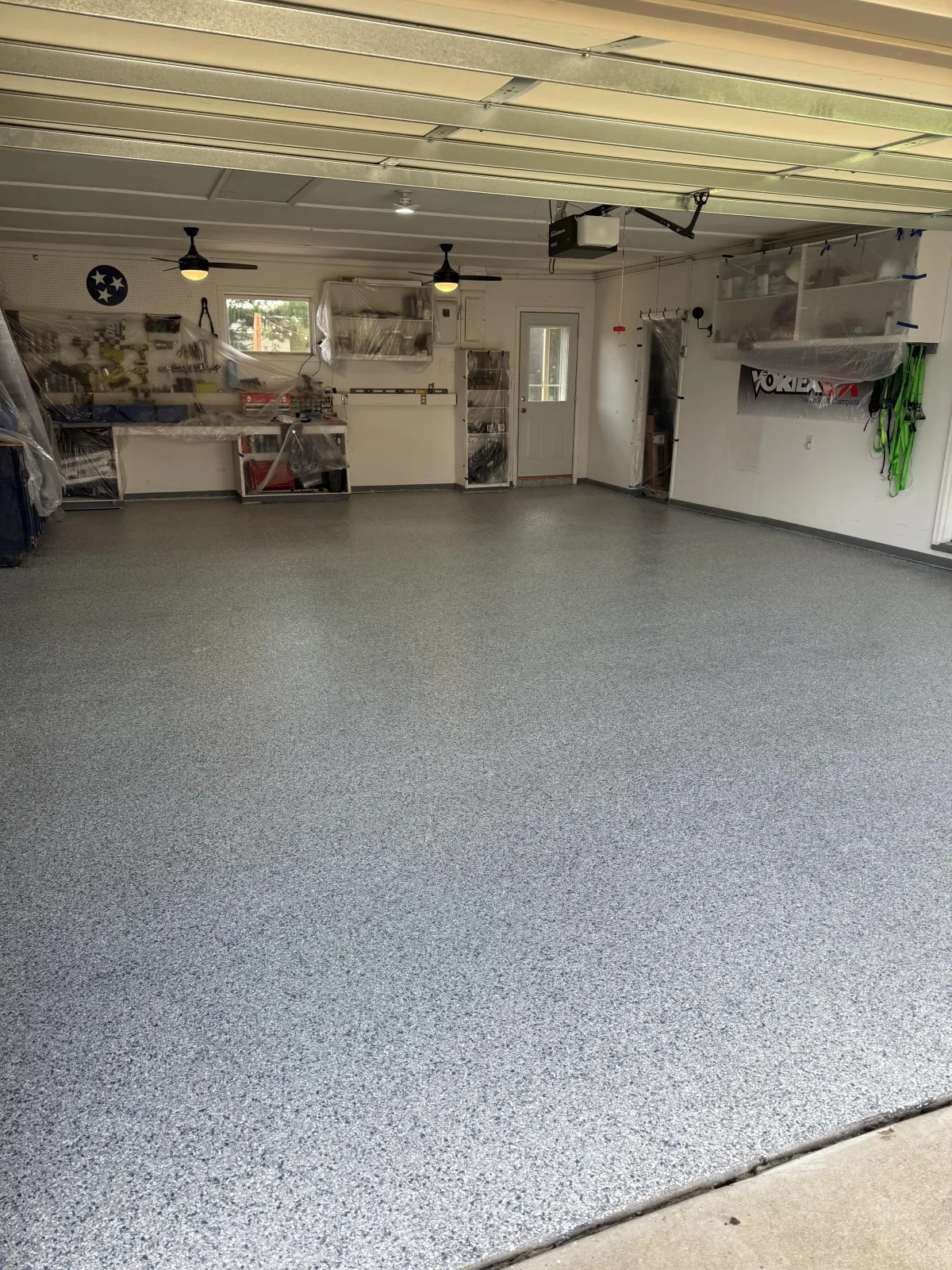
Garages
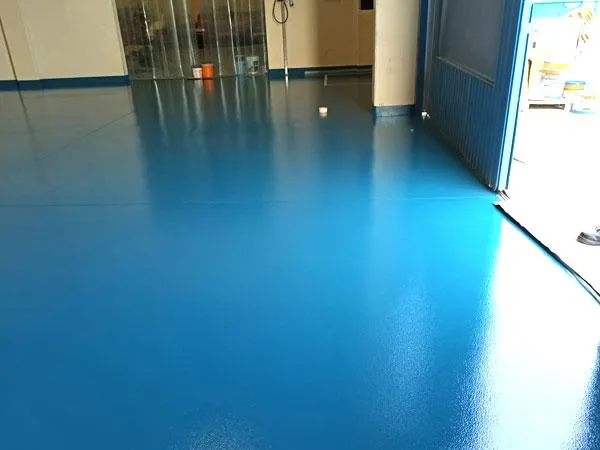
Let’s be real—most garage floors around here are cracked, stained, or covered in paint that’s peeling up every time you sweep. It’s not just an eyesore, it’s a constant reminder that the surface under your feet wasn’t built to last. That’s where flake epoxy comes in. It locks down your surface with a seamless, chemical-resistant coating that stands up to hot tires, road salt, gas spills, power tools, and everyday wear and tear. No peeling, no flaking, no tire marks burned into the finish.
Beyond durability, it completely changes the feel of the space. Instead of a dingy, dusty concrete slab, you’ve got a clean, high-performance surface that actually looks
like part of your home. It reflects light, brightens up the room, and makes your garage feel more like an extension of your living space. Whether you're parking your truck, working on weekend projects, or turning part of it into a home gym, flake epoxy gives you a floor that’s built for it all—and looks good doing it.
Basements
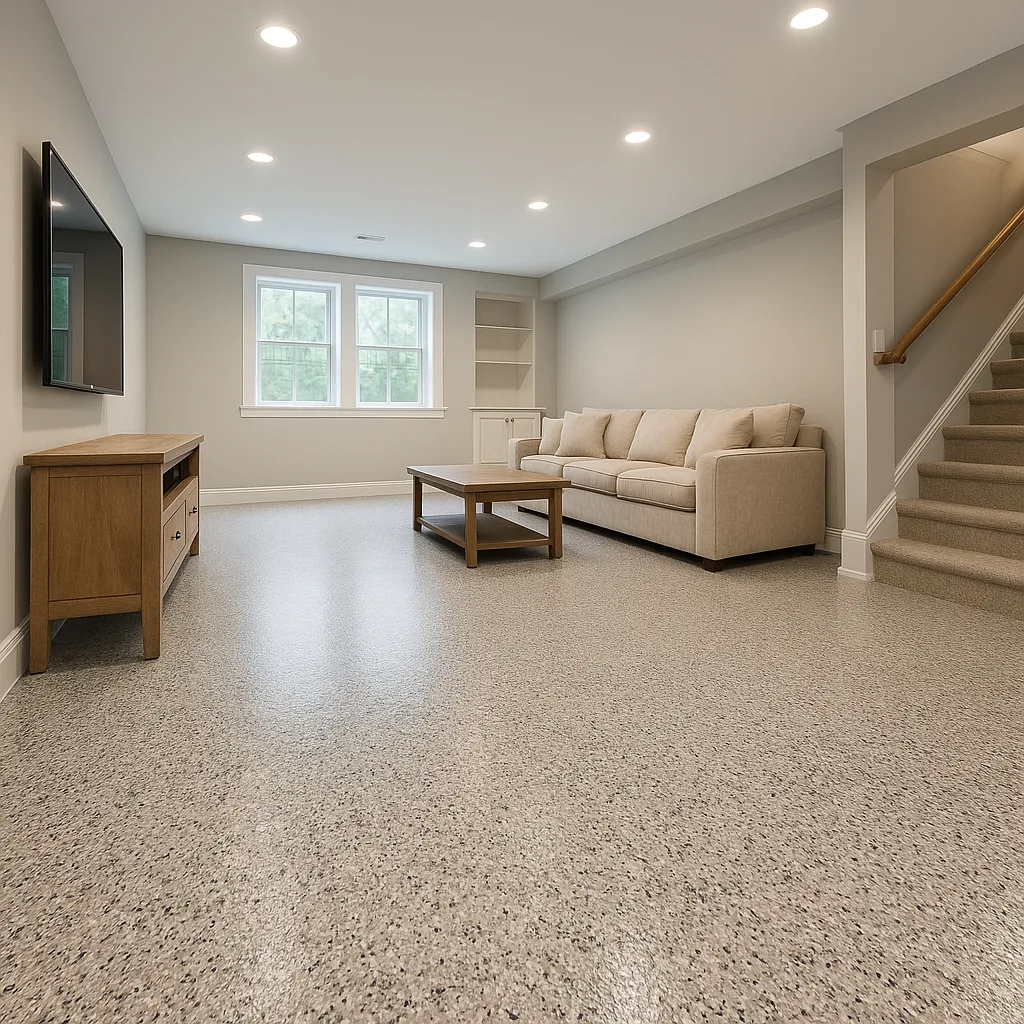
In places like Springfield, Decatur, and Champaign, basements come with their own set of challenges—humidity, moisture, ground movement, and unpredictable concrete quality. Raw concrete down there tends to absorb moisture, grow mold, and turn into a dust factory. Flake epoxy floors seal and protect your slab, creating a waterproof barrier that keeps moisture out and makes the space more livable.
It also makes cleaning a breeze—no more dust, no more musty smells, no more worrying about spills or pet accidents soaking into the concrete. Whether you’re converting your basement into a playroom, home gym, spare bedroom, or just want something that doesn’t feel like a dark storage pit, flake epoxy makes a massive difference. It transforms the space from forgotten to functional. And unlike carpet or tile, you won’t be replacing it in five years—it’s built to last.

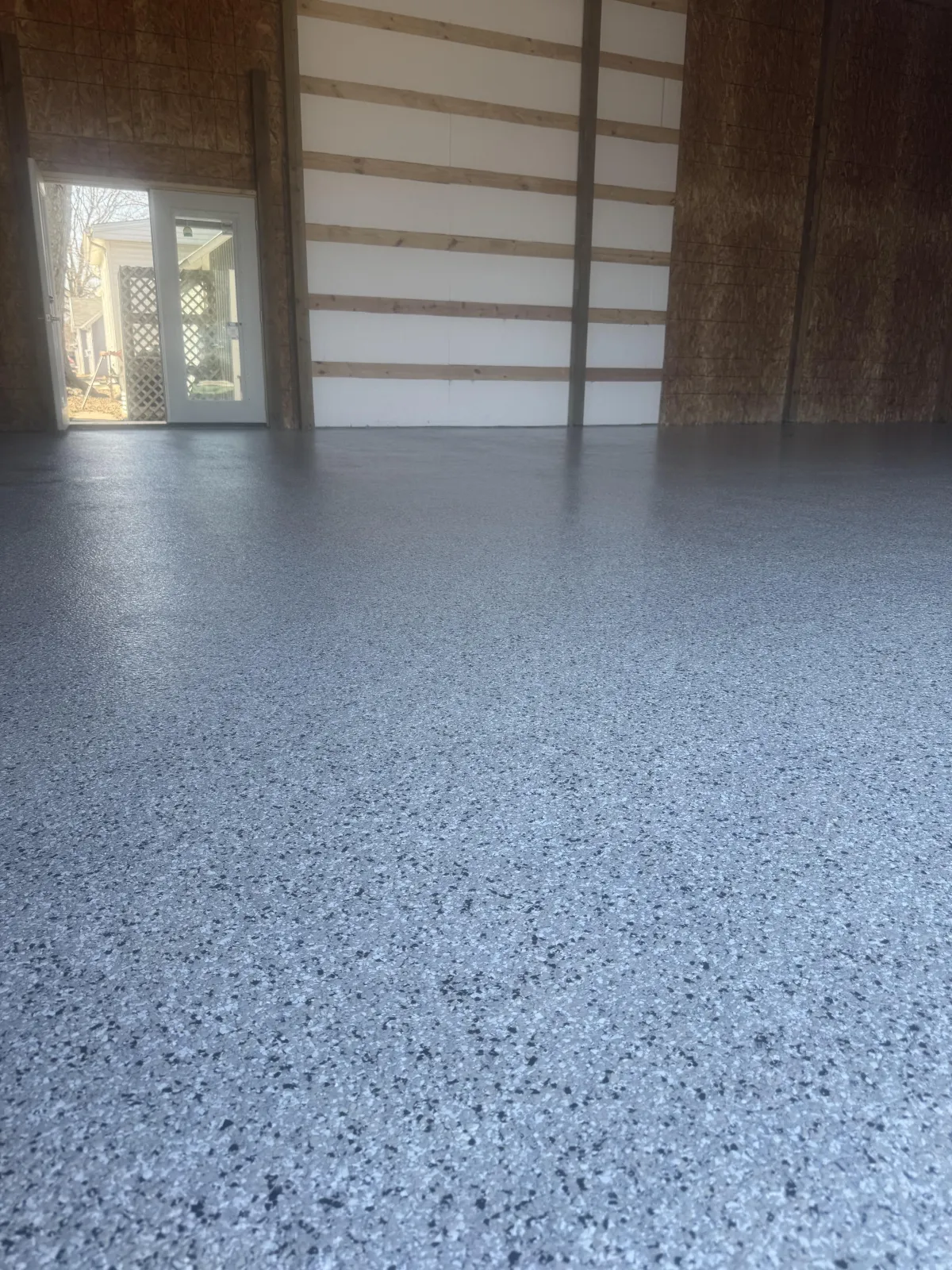
Workshops and Sheds

I’ve done plenty of floors for folks who wrench on cars, build furniture, restore antiques, or just want a solid workspace that doesn’t turn into a mess after one weekend project. Flake epoxy holds up to the daily grind—literally. It’s abrasion-resistant, chemical-resistant, and strong enough to handle dropped tools, heavy benches, floor jacks, and whatever else you throw at it. It’s the kind of surface you don’t have to baby.
The built-in texture from the flake system also adds grip, which means less slipping when you’re tracking in mud, sawdust, or oil. Plus, it’s easy to sweep or hose off—no cracks or seams to trap debris. Whether it’s a backyard shed, a pole barn, or a converted two-car garage, a flake epoxy system gives you a clean, bright, tough-as-nails surface that makes your workspace more efficient, safer, and easier to maintain.
Exterior Concrete (Patios, Walkways, Steps)
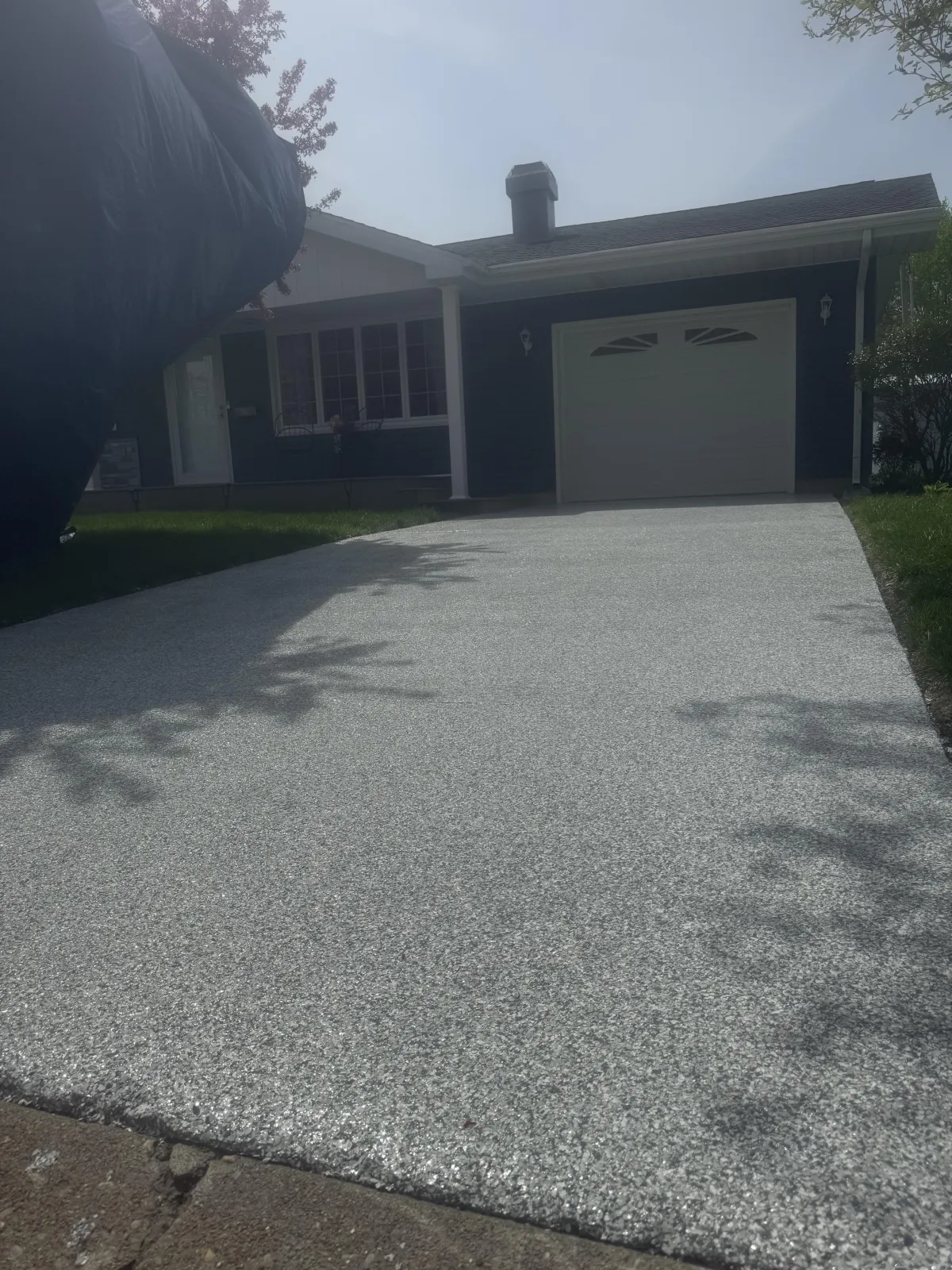
With the right topcoat, flake epoxy works great outside too. I use UV-stable polyaspartic finishes that hold up under sun exposure, rain, snow, and temperature swings—perfect for patios, porches, entry steps, and yes—even driveways. No more bare concrete that stains from every leaf and oil drip, or cracks that keep spreading every winter. You get a durable, seamless finish that stands up to the elements and looks good doing it.
For driveways, especially, flake epoxy provides a big upgrade. It resists tire marks, won’t flake or chip under weight, and doesn’t get slick in the rain like stamped concrete sometimes can. Want to add curb appeal without ripping up your driveway? This is the move. It’s also great for pool decks, walkways, and backyard entertaining areas—anywhere you want a surface that’s easy to clean, safe to walk on, and built to last through Midwestern weather.

Why Work With Miller’s Epoxy Solutions
There are a lot of companies out there slinging epoxy—and way too many of them are cutting corners to save time, not build quality. At Miller’s Epoxy Solutions, I don’t just show up and roll on some paint.
I do the prep right, I use the best materials available, and I install every single floor myself.
No subcontractors. No sales reps. No surprises.
Owner-installed floors, every time — No crews, no middlemen. I personally handle the entire process from prep to topcoat.
Thorough mechanical prep — I grind every slab to ensure a proper bond and long-term durability. No shortcuts, no acid wash gimmicks.
High-grade materials — I use commercial and industrial-grade epoxy and polyaspartic systems—not hardware store kits or watered-down coatings.
Local experience — I’ve worked on concrete all across Central Illinois. I understand the climate, the concrete issues, and what it takes to make a floor last here.
Tailored systems — No one-size-fits-all jobs. I recommend coatings based on how you plan to use your space.
Straightforward pricing — No vague estimates or surprise upcharges. You’ll know exactly what you’re getting and what it’ll cost.
15-year warranty — Every floor is backed by a real, written warranty. If something goes wrong, I’ll fix it—no excuses.
I built this business on reputation, not advertising. When your name’s on every job, it changes how you work.
That’s why homeowners and small businesses across Decatur, Springfield, and beyond trust me with their concrete.
What to Expect When You Work With Me
Getting a flake epoxy floor isn’t just about picking a color and hoping for the best. It’s a process—and when done right, it transforms your concrete and adds real value to your home or shop. I keep things simple, transparent, and on schedule.
Here’s exactly what you can expect when you hire Miller’s Epoxy Solutions:
1. Quick, No-Pressure Quote
Once you reach out, I’ll schedule a time to look at your space—no obligations, no pressure. I’ll take a look at your slab, measure things out, ask how you plan to use the floor, and give you a quote that’s clear, detailed, and locked in. No vague ranges. No hidden fees.
2. Honest Timeline and Scheduling
I’ll give you an honest timeline for when we can start and how long the install will take. Most residential jobs take 1–2 days depending on size and condition. If your floor needs extra prep or repairs, I’ll tell you up front. You’ll never get ghosted or left wondering when I’m showing up.
3. Professional Surface Prep
Before anything else, I mechanically grind the concrete to open up the pores and remove old paint, glue, stains, or sealers. This step is crucial —it ensures the coating bonds permanently to the slab and doesn’t peel down the road. I use commercial grinders with dust control, so the mess is minimal.
4. Crack Repair and Patching
If there are cracks, pits, or damage, I’ll repair them properly before the coating goes down. I don’t just “fill it and hope.” I use high-quality patch materials that cure strong and blend into the final finish.
5. Flake Epoxy Installation
Once the floor is prepped, I apply the base coat, broadcast the vinyl flakes until rejection (meaning full coverage), and then let everything cure properly. No rushing. No skipping steps. You get an even, solid layer that hides imperfections and adds slip resistance.
6. Topcoat with Polyaspartic or Clear Epoxy
After curing, I apply a high-performance topcoat—usually a UV-stable polyaspartic for faster return to service and better outdoor durability. This locks in the flakes, seals the surface, and gives your floor a clean, professional finish.
7. Final Walkthrough & Warranty
When it’s done, I walk the floor with you, explain care and maintenance, and answer any questions. You’ll get a written 15-year warranty and the peace of mind that comes with a floor installed by someone who stands behind their work.
FAQs About Flake Epoxy Flooring
How long does flake epoxy flooring last in a garage?
If it’s installed right—and I mean proper prep, full flake broadcast, and quality topcoats—flake epoxy flooring can last 15 years or more in a residential garage here in Central Illinois. I’ve seen floors in Decatur and Springfield that are still holding strong after a decade, even with daily vehicle traffic. But the real key is the condition of the concrete underneath and how well the coating was installed. We diamond grind every slab before we install to make sure the epoxy bonds like it’s supposed to. No shortcuts. No DIY paint kits. If you’re driving over it every day, parking hot tires, and maybe spilling a little oil or salt in the winter, you want a floor system that won’t peel or wear down after a year or two. That’s why I give a 15-year warranty. I don’t mess around with coatings that flake up or discolor. Done right, this floor will outlast most of what’s sitting on it.
Is flake epoxy flooring slippery when wet?
Great question, and the answer is—it depends on the finish. The flake itself adds texture, which already helps with grip. But in high-moisture areas like entryways, basements, or workshops that get wet from snowmelt or tracked-in water, I always recommend adding a slip-resistant additive in the topcoat. I use an aluminum oxide or silica blend that gives it some grit without making it hard to clean. You won’t even notice it visually, but it’ll keep you upright if you’re walking in with wet boots or socks. I’ve done garage floors in Springfield where the homeowner wanted to wash their car inside—no problem, I just bump up the anti-slip to match. The goal is to find the right balance between safety and cleanability. You don’t want it to feel like sandpaper, but you also don’t want to take a tumble. When I come out to do a quote, I always ask how you plan to use the space and tailor the grit level to match. Safety matters—and so does usability.
Can I choose the color and flake blend?
Absolutely—you’re not stuck with some one-size-fits-all option from a big box store. I’ve got dozens of flake blends to choose from, and if you’ve got something specific in mind—team colors, brand colors, or even something that hides dirt better—I can build a custom mix. A lot of folks around Decatur go for the granite-look flakes: gray, black, and white because they match almost any space and don’t show much grime. But I’ve also done bold red-and-black floors for car guys, tan blends for more natural light, and even blue tones for utility rooms. The flake layer isn’t just for show—it adds thickness, texture, and hides imperfections in older concrete. I do a full broadcast, which means you’ll get 100% coverage, not patchy flakes here and there. Then I seal it up with a high-gloss or satin topcoat, depending on the vibe you’re going for. When you book with me, I’ll bring samples so you can see and touch the options in person. It’s your floor—it should reflect your style.
What’s the installation process like for flake epoxy floors?
When I install a flake epoxy floor, it’s not a quick paint-and-go job—it’s a multi-step system that starts with surface prep. First, I diamond grind the concrete using commercial grinders. That removes old coatings, opens the pores, and gives the epoxy something to bite into. If there are cracks, spalls, or pits, I patch and level them. You don’t want to lock in flaws—fix them first. Then I roll on the base coat of epoxy and broadcast the vinyl flakes across the entire surface. I don’t do the light-sprinkle approach; this is a full-blown flake storm so you get a strong, textured surface. After that cures, I scrape and vacuum the flakes flat, then top it with a UV-stable polyaspartic or urethane clear coat. That topcoat is what seals it, gives it shine, and makes it resistant to hot tires, salt, oil, and water. The whole process usually takes two to three days start to finish, depending on temperature, humidity, and how rough the slab is. I’ll keep you updated every step of the way.
How much does flake epoxy flooring cost in Central Illinois?
Pricing depends on a few things—square footage, concrete condition, flake system used, and whether you want extras like extra grit or a satin finish. But to give you a ballpark, most residential garages in Decatur or Springfield run around $5–$7 per square foot for a full broadcast flake epoxy system with a clear topcoat. That includes prep, materials, labor—everything. If your concrete is in really bad shape or has a lot of leveling to do, that’ll bump the price up a bit. I don’t do cookie-cutter quotes—I come out, take a real look at your floor, and give you a firm price that includes everything. No hidden fees, no upsells. I also offer a 15-year warranty on all my flake systems, which most guys around here don’t. That means if something goes wrong because of how I installed it, I’ll make it right. If you’re price shopping, just make sure you’re comparing apples to apples—not a quick DIY job vs. a professional-grade install.
Can flake epoxy be installed in basements?
Yep—and honestly, it’s one of my favorite places to install it. A lot of basements in Central Illinois—especially in places like Springfield and Decatur—struggle with humidity, musty air, and concrete that’s seen better days. Flake epoxy is perfect for that. It locks out moisture from the top, gives you a clean, sealed surface, and makes the whole space feel more finished. Whether you’re turning it into a home gym, laundry room, or game room, it beats bare concrete by a mile. I use a moisture-tolerant primer first to make sure we’re not trapping any vapor coming up from below. Then we do a full broadcast flake system and seal it with a tough, UV-stable clear coat. It’s not just about looks—it’s about creating a healthier, more usable space. Bonus: it’s easy to clean, doesn’t stain easily, and resists mildew. If you’ve got pets or kids running around down there, this kind of flooring holds up way better than carpet or tile—and you won’t be stressing over spills.
Can you epoxy over an old painted or sealed floor?
Short answer? Not until the old coating is removed. I get this all the time—folks in Decatur or Springfield will say, “Hey, I’ve already got paint on my garage floor, can you just epoxy over it?” And the answer is no—not if you want it to last. Paint, sealers, or anything else sitting on that slab will weaken the bond of the new epoxy. You might get a few months out of it, but then it’ll start peeling, and that’s not how I do business. Before I install anything, I diamond grind the surface to remove paint, glue, old coatings—whatever’s there. That gives us a clean, porous concrete surface to bond to. If your slab has some rough spots or damage under the old coating, I’ll repair those before we move on. Once the floor’s prepped properly, that new flake epoxy system isn’t going anywhere. Prep is everything in this line of work—and I take it seriously.
How do I clean and maintain a flake epoxy floor?
Good news: flake epoxy is one of the lowest-maintenance floor options out there. For everyday cleanup, a soft broom or dust mop does the trick. Got some road salt or mud tracked in from Central Illinois winters? Just hose it down or use a mop with a mild cleaner. No fancy products needed—just skip the acidic stuff like vinegar or bleach, and don’t use abrasive pads that could dull the topcoat. If it’s in a garage or shop, I usually recommend a simple routine: sweep weekly, mop monthly, and rinse off any chemical spills right away. That clear topcoat is doing the heavy lifting—it protects your floor from stains, scratches, and fading. And because we do a full broadcast, you’re not going to see wear patches like you would on a painted floor. If you’re someone who likes your floor to always look fresh, I can also do a refresh topcoat after several years, but most customers don’t need it unless they’re really hard on the floor. Bottom line? These floors are built to work, not babysit.
Can flake epoxy be installed in the winter?
Yes—but with some caveats. I can install flake epoxy year-round in Central Illinois, including colder months in Decatur or Springfield, but temperature and humidity need to be controlled. Epoxy doesn’t like to cure below 50°F, and if the slab is too cold or there's too much moisture in the air, it can mess with the bond and the finish. In heated garages or indoor spaces, I can usually keep things on schedule even in January. But if it’s an unheated outbuilding or you’ve got frost under the slab, we may need to wait until things warm up—or bring in heaters to bring the surface temp up to spec. I’ll always do a moisture check before starting, and if there’s any risk of condensation or curing issues, I’ll be upfront with you. No one wants a floor that looks good for a week and then starts peeling. I’d rather push the schedule than cut corners. Winter installs are 100% doable—I’ve just got to be a bit more strategic.
What makes your flake epoxy better than the DIY kits at hardware stores?
Oh, don’t get me started. Those DIY kits look great on the shelf—until you use them. The stuff you get at the hardware store is usually water-based or single-part epoxy, which means it doesn’t bond as well, isn’t UV-stable, and wears out fast. I’ve redone a lot of those floors after they started peeling in less than a year. The difference with my system is in every layer—starting with diamond grinding your slab, which no DIY kit includes. Then I use commercial-grade, two-part epoxy and full-broadcast flakes for a thick, slip-resistant surface. And I top it off with a polyaspartic or urethane clear coat that actually holds up to hot tires, salt, gas spills—you name it. DIY kits don’t include that topcoat, and that’s why they fail. It’s like comparing a microwave dinner to a steakhouse meal—you get what you pay for. If you’re going to do it, do it once and do it right. I guarantee my installs for 15 years because I know the system works.
Will flake epoxy floors hold up to hot tires?
Yep—and that’s exactly why I use a commercial-grade system instead of the cheap stuff. One of the most common problems I see with DIY kits or low-end installs is what’s called "hot tire pickup." That’s when your tires heat up from driving, then cool down on the garage floor and literally pull the coating off with them. Not good. My system includes a proper grind on the concrete, a 2-part epoxy base, full flake broadcast for strength and texture, and a top-tier polyaspartic clear coat that’s specifically designed to resist heat and rubber transfer. I've done garages all over Decatur and Springfield, and every single one of them has to handle hot tire traffic—because let’s be honest, this isn’t Southern California. We’ve got real seasons here, with hot summers and cold winters, and that means big swings in surface temps. If the coating can't handle that, it won’t last. Mine does. I guarantee it with a 15-year warranty.
Can you fix cracks or uneven areas before installing flake epoxy?
Absolutely—prepping the concrete is half the job. If you’ve got cracks, pits, old glue from tile, or a slab that looks like it’s been through a war zone, don’t stress. I’ve fixed it all. Before I install any coating, I do a full diamond grind to clean and open up the surface. Then I go in and repair any cracks or spalled areas using an epoxy patch or fast-set polyurea filler, depending on what’s needed. If your floor isn’t level or has divots, I’ll take care of that too. I don’t install over bad concrete—that’s a fast track to peeling and bubbling. Springfield and Decatur have plenty of older homes and shops with concrete that’s past its prime. That’s why I build the repair work into every quote. When I leave, your slab isn’t just coated—it’s upgraded, sealed, and looking way better than when I showed up. No shortcuts. No surprises.
Is there a strong smell during installation?
There can be a smell, yeah—but it’s not overwhelming, and it doesn’t last. The base coat epoxy has a mild odor, but nothing crazy. The stronger smell usually comes from the polyaspartic or urethane topcoat. I use products that are low in VOCs (volatile organic compounds), and I always ventilate the space properly while I work. In a garage or basement, I’ll either keep the doors open or use fans to pull air through and keep fumes to a minimum. Most of the time, homeowners in Springfield or Decatur can stay in the house while I’m working—especially since the floors I do are usually in detached garages or lower levels. Once the topcoat cures (which happens fast), the smell is gone. If you’ve got sensitivities or someone in the house has asthma, just let me know ahead of time and I’ll make sure the plan works for you. Bottom line: it’s a short-term smell for a long-term win.
Can flake epoxy flooring be used in commercial spaces?
You bet—and it’s one of the most cost-effective commercial flooring systems out there. I’ve installed flake epoxy in everything from auto shops to vet clinics to retail back rooms. The reason it works so well is that it’s durable, seamless, chemical-resistant, and easy to clean. If you’re running a business in Springfield, Decatur, or anywhere in Central Illinois, you need a floor that doesn’t require babying—and this fits the bill. You can drive forklifts on it, spill cleaning products, deal with heavy foot traffic, and still expect it to hold up. Plus, it just looks sharp. I can customize the color blend to match your brand, and add anti-slip grit if needed for safety compliance. Whether it’s a warehouse, restaurant kitchen, or showroom floor, a full broadcast flake epoxy system gives you performance and aesthetics in one. And I can work around your schedule—nights, weekends, whatever it takes to minimize downtime.
What happens if moisture comes up through the concrete?
Ah, the old moisture problem—it’s more common than most people think, especially in basements and older garages around here. If moisture vapor is coming up through the slab and you install the wrong coating, it’ll bubble, peel, or delaminate within months. That’s why I always test for moisture before installing anything. I use a moisture meter to check the vapor emission rate of the slab. If it’s too high, I’ll apply a moisture-tolerant primer first, or even a full-blown moisture mitigation system if the readings are off the charts. The flake epoxy system itself isn’t permeable—it seals the surface completely—so we have to make sure we’re not trapping moisture underneath. I’ve dealt with plenty of basement floors in Springfield that had hydrostatic pressure issues and fixed them with the right prep and product combo. It’s not just about slapping on some epoxy—it’s about building a system that’ll hold up in your conditions. I treat every job like it’s going in my own home.
Is flake epoxy safe for pets?
Yep—once it’s cured, flake epoxy is 100% safe for pets. I’ve done plenty of floors for folks in Decatur and Springfield who’ve got dogs, cats, or even the occasional chicken wandering through the garage. During the install, you’ll want to keep pets out of the area—mainly because of the wet product and the smell. But once the floor cures, usually within 24–48 hours, there’s no odor, no off-gassing, and nothing toxic left behind. In fact, many pet boarding facilities and dog groomers use flake epoxy because it’s easy to clean, doesn’t hold odors, and won’t soak up urine or messes like concrete or tile grout does. If your pets shed, no problem—just sweep or vacuum. If they make a mess, hose it down. The surface is sealed and smooth, so nothing soaks in. And for older dogs who might slip, I can tweak the grit level in the topcoat to give them more traction without hurting their paws. Bottom line: it’s a pet-proof, people-proof floor that’ll make your life a lot easier.
What’s the difference between flake epoxy and solid color epoxy?
Good question. Both use the same base technology—an epoxy primer and topcoat—but flake epoxy adds an extra layer of performance and style. With solid color epoxy, you’re just tinting the resin and sealing it. It looks clean and professional, sure—but it doesn’t hide imperfections in the concrete nearly as well. Flake epoxy, on the other hand, uses a full broadcast of colored vinyl chips (flakes) across the surface. That flake layer adds texture, hides cracks or blemishes in the concrete, and creates a more forgiving surface. Plus, it gives you way more customization in terms of color. From a durability standpoint, flake systems are thicker, more impact-resistant, and offer better slip resistance when you add anti-skid grit. Most of my residential garage customers in Springfield and Decatur go with flake epoxy because it holds up better and looks way more high-end. Solid color is still a good option for some interiors or light-use areas, but flake is the heavy-duty, show-stopper upgrade.
Can I park my car on it right away after installation?
Not quite—you’ll need to wait a bit. After I install your flake epoxy floor, the curing time depends on temperature and humidity, but I typically recommend:
24 hours before walking on it,
48 hours before moving light items back in, and
5 to 7 days before parking vehicles.
The reason is, the epoxy and topcoat need time to fully harden and reach their maximum durability. If you drive on it too soon, hot tires can cause impressions or even pull up sections of the coating. I know you’ll be excited to use the space—everyone is—but trust me, waiting a few days ensures that your floor lasts for years, not months. I’ll give you clear instructions after install and even check the forecast to make sure we’re not battling crazy humidity or temps during the cure. If you’re in a hurry, I can use a fast-cure system, but I’ll walk you through the pros and cons when we do the quote.
Do flake epoxy floors yellow over time?
Not if you use the right topcoat. That yellowing you see in old garage floors or DIY kits is usually from UV exposure breaking down the resin. Most big-box epoxy kits don’t include a UV-stable top layer, so over time, sunlight (even through garage windows) turns them amber or dingy. That’s why I finish all my flake epoxy installs with a UV-resistant polyaspartic or urethane topcoat. It keeps the color true, even in direct sun. I’ve done garage and shop floors in sunny areas of Springfield and Decatur that look just as fresh years later. And if you’re doing a flake blend with lighter colors like gray, white, or tan, UV protection is especially important—they’ll show discoloration faster without it. I don’t skip that step. If I’m putting my name on it, it needs to look good for the long haul. Yellowing floors are a sign of corner-cutting. That’s not how I work.
Can flake epoxy be used on outdoor surfaces?
It can—but only with the right system. I don’t recommend standard indoor epoxy systems for outdoor patios, porches, or walkways in Central Illinois because traditional epoxy doesn’t handle direct UV or freeze/thaw cycles well. But if you want the look and texture of flake outdoors, I’ve got modified systems that work. Typically, I’ll use a polyurea or polyaspartic base that can expand and contract with temperature changes and won’t break down in the sun. I’ve done outdoor entries and covered patios with custom flake blends that look great and hold up to snow, salt, and summer heat. Just keep in mind outdoor surfaces need more traction, so I’ll bump up the grit level for slip resistance. And drainage matters too—I’ll make sure water isn’t pooling and breaking things down over time. If you’ve got a front step or back patio that looks like it’s been through a tornado, we can clean it up, coat it, and give it years of new life.

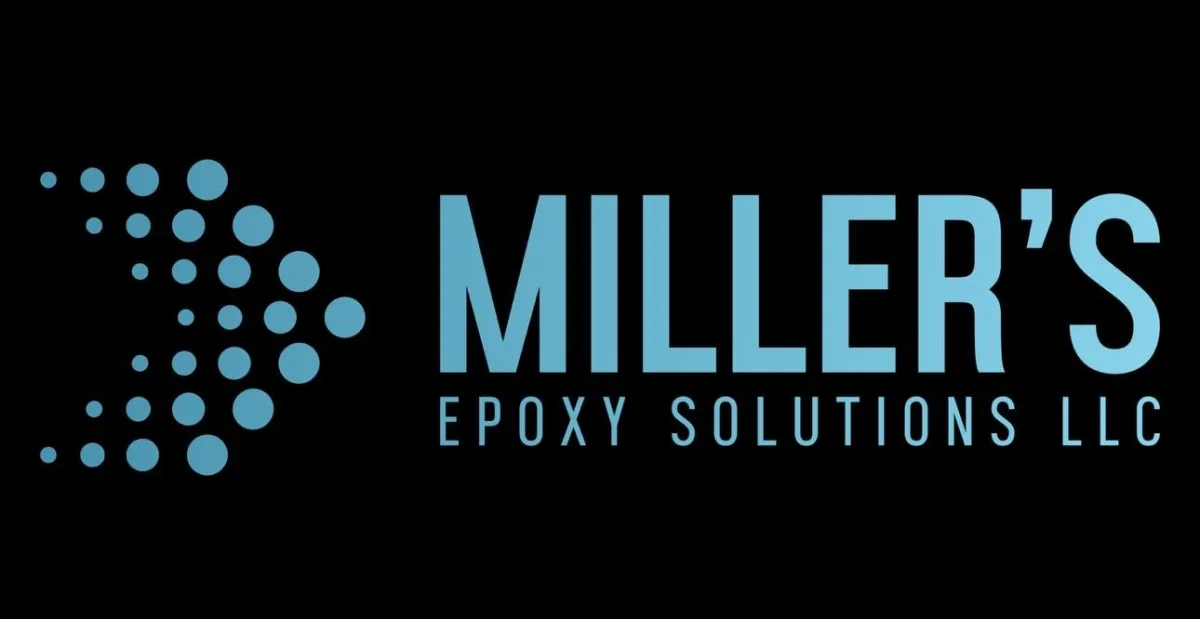
Facebook
Instagram